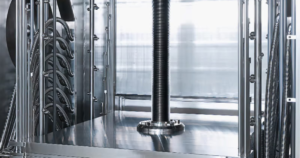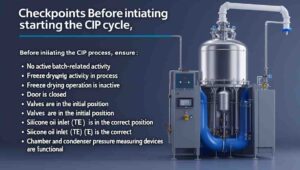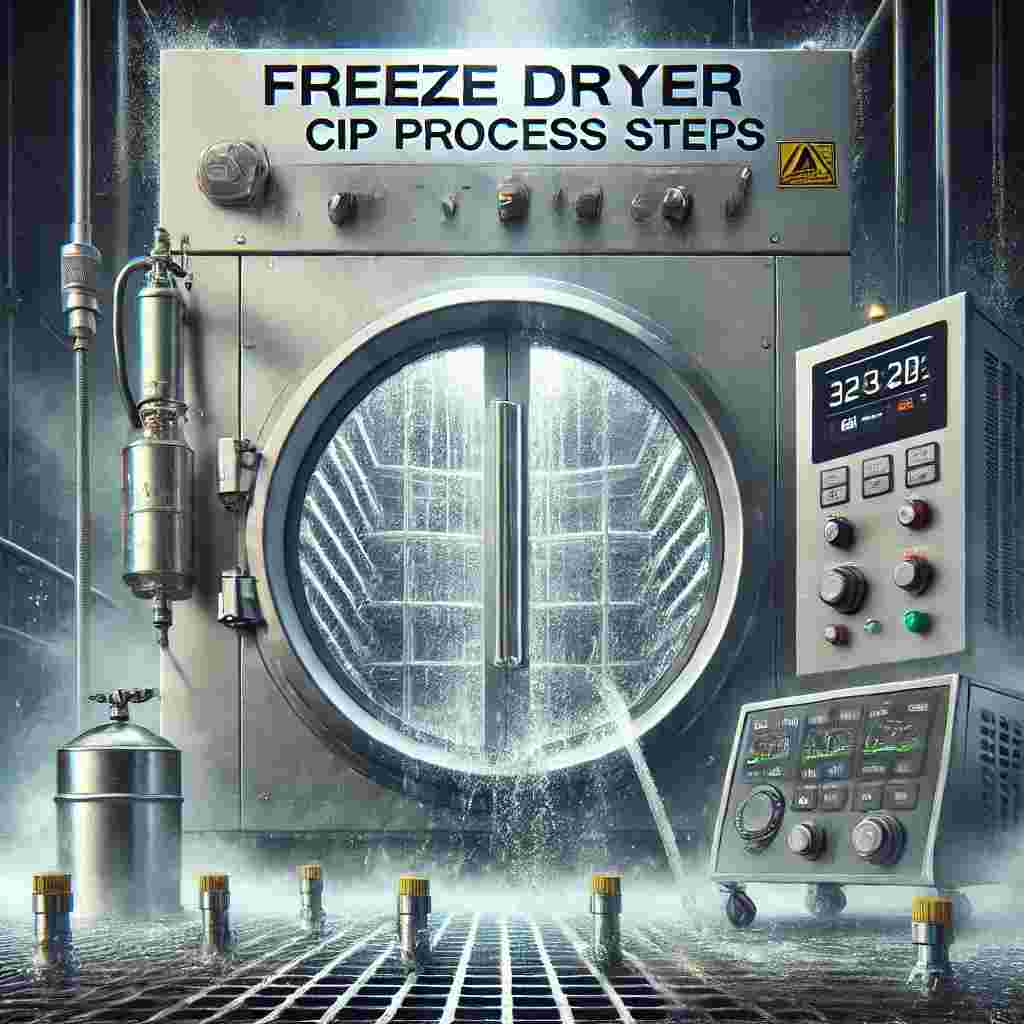The Clean In Place in Freeze Drying (CIP) process is a critical step in maintaining the efficiency and sterility of a freeze dryer. It ensures the removal of contaminants, product residues, and microbial impurities without disassembling the equipment.
A well-executed CIP cycle enhances freeze-drying performance, prolongs equipment life, and ensures compliance with pharmaceutical regulations. This article outlines the key steps in the CIP process and the necessary checkpoints to ensure optimal system cleaning and validation.
👉 Related: Freeze Dryer Online Filter Integrity Test
Table of Contents
ToggleWhy Clean-In-Place in Freeze Drying is Important

- Prevents Contamination: During freeze-drying, particulates can spread onto the internal surfaces of the freeze dryer, leading to contamination.
- Maintains Hygiene: Cleaning with water and/or alcohol helps sanitize surfaces, ensuring a hygienic process.
- Ensures Consistency: Manual cleaning is difficult to validate, making Clean In Place (CIP) a preferred method for repeatability and easier validation.
- Effective Cleaning Process: CIP allows thorough cleaning by spraying liquid inside the freeze dryer, ensuring better removal of residues.
- Customizable Cleaning Methods: CIP systems vary in complexity, from simple rinsing with filtered water to advanced scrubbing and sanitization using detergents and multiple rinse cycles.
Set parameter of Clean-In-Place in Freeze Drying
1. Pre-Rinsing Phase
The pre-rinsing phase is the first step in the Clean In Place (CIP) process, designed to remove initial residues and particulates from the freeze dryer’s internal surfaces.
- Spraying Time per Spray Tube: 80 seconds
- Number of CIP Cycles: 5 times
- Draining Time: 20 minutes
- Additional Spraying Time per Spray Tube: 70 seconds
- Draining Time: 25 minutes
2. Re-Rinsing Phase
This phase ensures that any remaining cleaning solution or contaminants are fully washed out, preparing the freeze dryer for safe use.
- Shelves Lowering Time: 70 seconds
- Venting Gas Used: Air
- Draining Time: 40 minutes
- Cleaning Solution Used: WFI (Water for Injection)
Cleaning Solution Used: WFI (Water for Injection) is used to achieve the highest level of cleanliness, as it is free from contaminants and impurities.
3. Final Rinse with Purified Water during Clean-In-Place
- The entire system is thoroughly rinsed with purified water to remove any traces of the cleaning solution, ensuring no residues remain.
👉 Related: Vacuum Chamber Lyophilization
Checkpoints Before Starting the Clean-In-Place in Freeze Drying

Before initiating the CIP process, ensure the following conditions:
✅ No active batch-related activity in process
✅ Freeze drying operation is inactive
✅ Door is closed
✅ Valves are in the initial position
✅ Silicone oil inlet (TE) is in the correct position
✅ Chamber and condenser pressure measuring devices are functional
👉 Related: Freeze Dryer Leak Test: Comprehensive Guide
Conclusion
A well-structured CIP process is essential for maintaining the hygiene, efficiency, and reliability of a freeze dryer. It prevents contamination, ensures regulatory compliance, and enhances lyophilization performance. By following the key steps and pre-cycle checks, industries can improve the longevity and functionality of their freeze-drying units.
👉 Related: Lyophilizer Cleaning Validation
Summary
- The CIP process in a freeze dryer consists of pre-rinsing, re-rinsing, and final purified water rinse.
- Key parameters include spray tube time, CIP cycles, draining times, and venting gas selection.
- Checkpoints before CIP ensure that all components are in their correct initial positions before the cycle begins.
- Proper cleaning validation ensures compliance with cGMP regulations and enhances equipment longevity.
👉 Related: Lyophilization Validation: Best Practices 2025
FAQs of Clean-In-Place in Freeze Drying
1. What is the purpose of the CIP process in a freeze dryer?
The CIP process removes contaminants, product residues, and microbial impurities from the freeze dryer without disassembling the equipment, ensuring hygiene and regulatory compliance.
2. How many CIP cycles are required for pre-rinsing?
The pre-rinsing phase requires 5 CIP cycles, followed by additional spray tube rinsing and draining.
3. What type of cleaning solution is used in the CIP process?
The process typically uses Water for Injection (WFI) for cleaning and purified water for final rinsing.
4. Why is venting gas important in the CIP process?
Venting gas, such as air, helps remove excess cleaning solution and moisture, ensuring the freeze dryer is ready for operation.
👉 Related: Freeze Dryer Troubleshooting Guide
